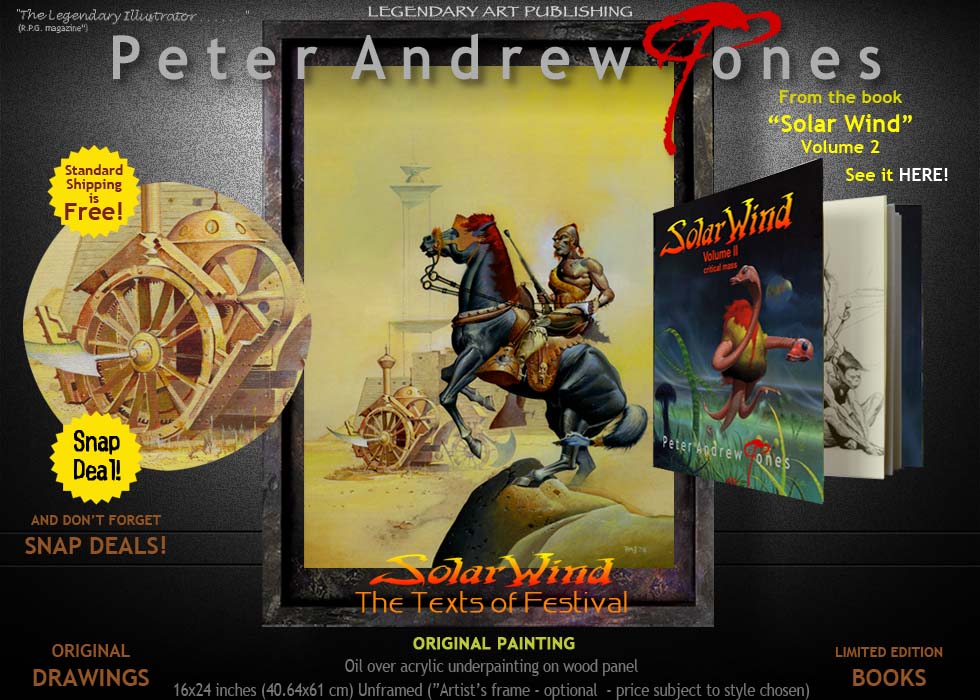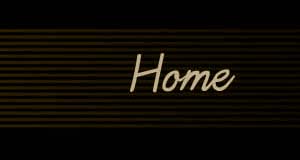|
The
ultimate collector's luxury editions contain
original archive drawings
in either graphite or metalpoint taken from the
artist's personal
archives. Sewn into the book and artist-signatured
they are the
ultimate in quality collectible books.

|
£ ASK Regular Shipping is Regular Shipping is
 Currency
converter Currency
converter Join
our Newsletter Join
our Newsletter
|
The
ultimate collector's luxury editions. Limited edition,
giclee printed,
handmade, paint encrusted hardback cover, wraparound
dust jacket,
original archive drawing in the title page,
presentation box, artist
signed.
 |
 The Texts of Festival The Texts of Festival
 (From the book "Solar Wind volume 2") (From the book "Solar Wind volume 2")
 By :
Deborah Susan Jones :
Editor By :
Deborah Susan Jones :
Editor
 Mick Farren's
stunning first novel, set in a post apocalyptic world,
in some ways a
portent of much of today's issues, where breakdown in
society leaves
towns, even cities, falling into decay or receding into
feelings of blinkered security as life struggles on in
the
central core. In many ways, the underground press, in
which Mick was a
leading player, foretold so much about today's world. Mick Farren's
stunning first novel, set in a post apocalyptic world,
in some ways a
portent of much of today's issues, where breakdown in
society leaves
towns, even cities, falling into decay or receding into
feelings of blinkered security as life struggles on in
the
central core. In many ways, the underground press, in
which Mick was a
leading player, foretold so much about today's world.
 Published
in 1975 by Panther Books in the UK with a cover created
by the
artist, this commission to provide cover art
eventually led to covers of the Jeb Stuart Ho trilogy,
the Quest of the
DNA Cowboys (1976), Synaptic Manhunt (1976) and
Neural Atrocity
(1977) and all were a thrill to illustrate referencing
as they do the
counter-culture scene of the time, rock &roll and
the whole 60s into
70s alternative culture explosion that the artist found
himself centered
in the middle of both culturally and geographically
being based in
London and growing up in the period. Published
in 1975 by Panther Books in the UK with a cover created
by the
artist, this commission to provide cover art
eventually led to covers of the Jeb Stuart Ho trilogy,
the Quest of the
DNA Cowboys (1976), Synaptic Manhunt (1976) and
Neural Atrocity
(1977) and all were a thrill to illustrate referencing
as they do the
counter-culture scene of the time, rock &roll and
the whole 60s into
70s alternative culture explosion that the artist found
himself centered
in the middle of both culturally and geographically
being based in
London and growing up in the period.
 In
a modern version of the fall of Rome the bleak
scene of Britain
has eroded into a de-civilised place, decadent, and the
people cower in
the city of Festival. The words of the old ones have
been largely
forgotten, Morrizen, Dhillon,
and Djeggar, stored on black discs that house the music
and prophesies
of these Gods while outside the city barbaric tribes are
massing and hell, drug-driven satanic
horse riders
bent on rape, pillage and slaughter, is about to break
loose. In
a modern version of the fall of Rome the bleak
scene of Britain
has eroded into a de-civilised place, decadent, and the
people cower in
the city of Festival. The words of the old ones have
been largely
forgotten, Morrizen, Dhillon,
and Djeggar, stored on black discs that house the music
and prophesies
of these Gods while outside the city barbaric tribes are
massing and hell, drug-driven satanic
horse riders
bent on rape, pillage and slaughter, is about to break
loose.
 "By
the time depicted in the story I imagined that creatures
such as horses
would have been biogenetically altered so that they
seemed almost metal,
robot-like and I imagined that the massing tribal
warriors might have
adopted clothing looted from museum collections of Wild
West clothing
and horse trappings and that their skin would be
oily-slick and
unwashed from living a wild existence. "By
the time depicted in the story I imagined that creatures
such as horses
would have been biogenetically altered so that they
seemed almost metal,
robot-like and I imagined that the massing tribal
warriors might have
adopted clothing looted from museum collections of Wild
West clothing
and horse trappings and that their skin would be
oily-slick and
unwashed from living a wild existence.
 "Untypically,
and because it was a time of huge experimentation for
me, I chose to
paint this piece on canvas textured illustration board,
bought from a
now long defunct art shop in Shaftsbury Avenue in London
called Wheatsheaf. It
was a lovely surface to paint on, tough and lightly
textured yet being
a board without the hassle of stretching on a frame as
with traditional
roll canvas, and the experience was an entirely new one
to me who'd
been used to painting on stretched paper up to that
point in time. "Untypically,
and because it was a time of huge experimentation for
me, I chose to
paint this piece on canvas textured illustration board,
bought from a
now long defunct art shop in Shaftsbury Avenue in London
called Wheatsheaf. It
was a lovely surface to paint on, tough and lightly
textured yet being
a board without the hassle of stretching on a frame as
with traditional
roll canvas, and the experience was an entirely new one
to me who'd
been used to painting on stretched paper up to that
point in time.
 "The
steam-driven tank-like machine with the bladed heavy
wheels came from
the blended ideas of a collapsed civilisation maybe
having to fall back
to relying on steam driven vehicles, to scythes on the
wheel hubs as in
the Ben Hur movie I'd seen when I was younger and the
marriage of 1st
World war tank technology with the kind of steam
mechanism seen on early
motor vehicles. I had a lot of fun dreaming that
contraption up! "The
steam-driven tank-like machine with the bladed heavy
wheels came from
the blended ideas of a collapsed civilisation maybe
having to fall back
to relying on steam driven vehicles, to scythes on the
wheel hubs as in
the Ben Hur movie I'd seen when I was younger and the
marriage of 1st
World war tank technology with the kind of steam
mechanism seen on early
motor vehicles. I had a lot of fun dreaming that
contraption up!
 "The
background colour was chosen to give the idea of the
world being a
hotter place in the future as the Earth would be in a
nearer orbit to
the sun than currently and envisaged global warming from
that viewpoint
rather than any idea of it being caused by human
actions. "The
background colour was chosen to give the idea of the
world being a
hotter place in the future as the Earth would be in a
nearer orbit to
the sun than currently and envisaged global warming from
that viewpoint
rather than any idea of it being caused by human
actions.
 "The
book, and the opportunity to create cover art for it,
was a fabulous
introduction to Mick's work and his later DNA Cowboys
trilogy which I
had the great pleasure of covering and he was a very
interesting person
to talk to about visual concepts and certainly a "design
meeting" (I'm
not sure if it had that grand a title back then) between
myself, Mick
and Panther Book's Art Director Steve Abis, was a
interesting event to
say the least, oscillating between discussion about
cover art proposals
and the last Rolling Stones album and gig, primarily
because we were
both Rolling Stones fans and their drummer Charlie Watts
was a good
friend of Steve's and Mich was of course a Rock music
journalist and
performer as well, so all in all, it made for an
interesting Friday
night meeting and the promise of a subsequents date for
a "decent
curry"
courtesy of Panther's budget for being prepared to turn
out on a Friday
night when I might have otherwise been engaged and
eventually we ended
up at Steve's favourite, and fabulous, Indian Restaurant
in Tottenham
Court Road. "The
book, and the opportunity to create cover art for it,
was a fabulous
introduction to Mick's work and his later DNA Cowboys
trilogy which I
had the great pleasure of covering and he was a very
interesting person
to talk to about visual concepts and certainly a "design
meeting" (I'm
not sure if it had that grand a title back then) between
myself, Mick
and Panther Book's Art Director Steve Abis, was a
interesting event to
say the least, oscillating between discussion about
cover art proposals
and the last Rolling Stones album and gig, primarily
because we were
both Rolling Stones fans and their drummer Charlie Watts
was a good
friend of Steve's and Mich was of course a Rock music
journalist and
performer as well, so all in all, it made for an
interesting Friday
night meeting and the promise of a subsequents date for
a "decent
curry"
courtesy of Panther's budget for being prepared to turn
out on a Friday
night when I might have otherwise been engaged and
eventually we ended
up at Steve's favourite, and fabulous, Indian Restaurant
in Tottenham
Court Road.
 "The
main thing I recall from the meeting though, was not
discussion about
book cover design, but me sitting on a chair in a corner
with Mick's
stuffed Ant Eater, mounted on a plinth, as an arm rest." "The
main thing I recall from the meeting though, was not
discussion about
book cover design, but me sitting on a chair in a corner
with Mick's
stuffed Ant Eater, mounted on a plinth, as an arm rest."
 Sadly,
Mick died after collapsing on stage in July 2013 during
a reunion of
his Deviants rock band while performing at the London
live-music venue
The Borderline. Sadly,
Mick died after collapsing on stage in July 2013 during
a reunion of
his Deviants rock band while performing at the London
live-music venue
The Borderline.
 Equally
sadly, Steve Abis, the incredibly talented art director
at Panther
Books, who taught Peter so much, died far too young, and
though never
gets a mention as a virtual unknown outside of the
paperback industry
of the 1970s, was undoubtedly one of the main
contributors to the 1970s
revolution in Science Fiction book cover design,
particularly from the
perspectives of his brilliant cover typography and his
choice of cover
artists and, not least of all, his guidance of a very
young up and
coming artist, Peter Andrew Jones . . . . . . (r.i.p) Equally
sadly, Steve Abis, the incredibly talented art director
at Panther
Books, who taught Peter so much, died far too young, and
though never
gets a mention as a virtual unknown outside of the
paperback industry
of the 1970s, was undoubtedly one of the main
contributors to the 1970s
revolution in Science Fiction book cover design,
particularly from the
perspectives of his brilliant cover typography and his
choice of cover
artists and, not least of all, his guidance of a very
young up and
coming artist, Peter Andrew Jones . . . . . . (r.i.p)
 Deborah Susan Jones Deborah Susan Jones
|








